Mechanical Properties of Seawater Sea-Sand Concrete Exposed to Daily Temperature Variations
Abstract
:1. Introduction
2. Experimental Program
2.1. Materials
2.2. Simulation of Daily Temperature
2.3. Specimens
2.4. Experimental Setup and Instrumentation
3. Experimental Results and Discussions
3.1. Failure Modes
3.2. Stress–Strain Relationship
3.3. Compressive Strength
3.4. Young’s Modulus, Ultimate Strain and Poisson’s Ratio
3.5. Toughness
3.6. Microstructures of SSC
4. Stress–Strain Model for Seawater Sea-Sand Concrete
4.1. Concrete Strength and Corresponding Strain
4.2. Stress–Strain Relationship
5. Conclusions
- (1)
- At 60 °C, the compressive strength of SSC increases when the number of thermal cycling times increases due to the further hydration of cement. However, if the target temperature is 100 °C, the compressive strength of SSC is reduced, as microcracks are formed in the SSC interfacial transition zone by the unmatchable expansion and contraction of aggregates and paste.
- (2)
- Young’s modulus and the ultimate strain of SSC are functions of compressive strength, and the influence of thermal cycling is indirect. Poisson’s ratio of SSC decreases slightly with the increase in cycling times.
- (3)
- Compared to that of unconditioned SSC, the toughness of SSC subjected to thermal cycling is higher, as the strength is increased, and the post-peak branch of the stress–strain curve is flat.
- (4)
- A theoretical model is proposed to predict the stress–strain relationship of SSC under temperature variations, and the prediction closely matches the experimental results. It is necessary to mention that the proposed formulas are based on the specimens with temperatures ranging from 25 to 100 °C and cycling times ranging from 30 to 150 times.
Author Contributions
Funding
Institutional Review Board Statement
Informed Consent Statement
Data Availability Statement
Acknowledgments
Conflicts of Interest
References
- Fang, Z.; Fang, H.; Huang, J.; Jiang, H.; Chen, G. Static behavior of grouped stud shear connectors in steel-precast UHPC composite structures containing thin full-depth slabs. Eng. Struct. 2022, 252, 113484. [Google Scholar] [CrossRef]
- Sun, C.; Chen, L.; Xiao, J.; Singh, A.; Zeng, J. Compound utilization of construction and industrial waste as cementitious recycled powder in mortar. Resour. Conserv. Recycl. 2021, 170, 105561. [Google Scholar] [CrossRef]
- Sun, C.; Chen, Q.; Xiao, J.; Ge, W. Study on Aggregate Interlock Behavior of Pre-Cracked Recycled Aggregate Concrete without Stirrups. J. Build. Eng. 2021, 39, 102257. [Google Scholar] [CrossRef]
- Liu, X.; Liu, L.; Lyu, K.; Li, T.; Zhao, P.; Liu, R.; Zuo, J.; Fu, F.; Shah, S.P. Enhanced early hydration and mechanical properties of cement-based materials with recycled concrete powder modified by nano-silica. J. Build. Eng. 2022, 50, 104175. [Google Scholar] [CrossRef]
- Li, T.; Liu, X.; Zhang, Y.; Yang, H.; Zhi, Z.; Liu, L.; Ma, W.; Shah, S.P.; Li, W. Preparation of sea water sea sand high performance concrete (SHPC) and serving performance study in marine environment. Constr. Build. Mater. 2020, 254, 119114. [Google Scholar] [CrossRef]
- Tjaronge, M.W.; Irmawaty, R.; Adisasmita, S.A.; Amiruddin, A.; Hartini. Compressive strength and hydration process of self compacting concrete (SCC) mixed with sea water, marine sand and portland composite cement. Adv. Mat. Res. 2014, 935, 242–246. [Google Scholar] [CrossRef]
- Younis, A.; Ebead, U.; Suraneni, P.; Nanni, A. Fresh and hardened properties of seawater-mixed concrete. Constr. Build. Mater. 2018, 190, 276–286. [Google Scholar] [CrossRef]
- Xiao, J.; Qiang, C.; Nanni, A.; Zhang, K. Use of sea-sand and seawater in concrete construction: Current status and future opportunities. Constr. Build. Mater. 2017, 155, 1101–1111. [Google Scholar] [CrossRef]
- Liu, W.; Cui, H.; Dong, Z.; Xing, F.; Zhang, H.; Lo, T.Y. Carbonation of concrete made with dredged marine sand and its effect on chloride binding. Constr. Build. Mater. 2016, 120, 1–9. [Google Scholar] [CrossRef]
- Xiao, J.; Long, X.; Qu, W.; Li, L.; Jiang, H.; Zhong, Z. Influence of sulfuric acid corrosion on concrete stress-strain relationship under uniaxial compression. Measurement 2022, 187, 110318. [Google Scholar] [CrossRef]
- Mohammed, T.U.T.; Hamada, H.; Yamaji, T. Performance of seawater-mixed concrete in the tidal environment. Cem. Concr. Res. 2004, 34, 593–601. [Google Scholar] [CrossRef]
- Xie, J.; Li, Y.; Lu, Z.; Fan, Z.; Li, J.; Li, S. Effects of immersion in water, alkaline solution and seawater on the shear performance of BFRP bars embedded in seawater sea-sand concrete. J. Compos. Constr. 2022, 26, 04021071. [Google Scholar] [CrossRef]
- Xiong, Z.; Lin, L.; Qiao, S.; Li, L.; Li, Y.; He, S.; Li, Z.; Liu, F.; Chen, Y. Axial performance of seawater sea-sand concrete columns reinforced with basalt fibre-reinforced polymer bars under concentric compressive load. J. Build. Eng. 2022, 47, 103828. [Google Scholar] [CrossRef]
- Li, Y.L.; Zhao, X.L.; Raman Singh, R.K.; Al-Saadi, S. Experimental study on seawater and sea sand concrete filled GFRP and stainless steel tubular stub columns. Thin-Walled Struct. 2016, 106, 390–406. [Google Scholar] [CrossRef]
- Dong, Z.; Wu, G.; Zhao, X.-L.; Zhu, H.; Lian, J.-L. Durability test on the flexural performance of seawater sea-sand concrete beams completely reinforced with FRP bars. Constr. Build. Mater. 2018, 192, 671–682. [Google Scholar] [CrossRef]
- Nishida, T.; Otsuki, N.; Ohara, H.; Garba-Say, Z.M.; Nagata, T. Some considerations for applicability of seawater as mixing water in concrete. J. Mater. Civ. Eng. 2015, 7, B4014004. [Google Scholar] [CrossRef] [Green Version]
- El-Salakawy, E.; Benmokrane, B.; El-Ragaby, A.; Nadeau, D. Field investigation on the first bridge deck slab reinforced with glass FRP bars constructed in Canada. J. Compos. Constr. 2005, 9, 470–479. [Google Scholar] [CrossRef]
- Limeira, J.; Agullo, L.; Etxeberria, M. Dredged marine sand in concrete: An experimental section of a harbor pavement. Constr. Build. Mater. 2010, 24, 863–870. [Google Scholar] [CrossRef]
- Mehta, P.K.; Monteiro, P.J.M. Concrete: Microstructure, Properties, and Materials, 3rd ed.; McGraw-Hill, New York, NY, USA, 2006.
- Wegian, F.M. Effect of seawater for mixing and curing on structural concrete. IES J. Part A Civ. Struct. Eng. 2010, 3, 235–243. [Google Scholar] [CrossRef]
- Xiong, Z.; Mai, G.; Qiao, S.; He, S.; Zhang, B.; Wang, H.; Zhou, K.; Li, L. Fatigue bond behaviour between basalt fibre-reinforced polymer bars and seawater sea-sand concrete. Ocean. Coast. Manag 2022, 218, 106038. [Google Scholar] [CrossRef]
- Tang, Y.; Feng, W.; Chen, Z.; Nong, Y.; Guan, S.; Sun, J. Fracture behavior of a sustainable material: Recycled concrete with waste crumb rubber subjected to elevated temperatures. J. Clean Prod. 2021, 318, 128553. [Google Scholar] [CrossRef]
- Silva, M.A.G.; Biscaia, H.; Chastre, C. Influence of temperature cycles on bond between glass fiber-reinforced polymer and concrete. ACI Struct. J. 2013, 110, 977–987. [Google Scholar]
- Wang, Z.; Zhao, X.-L.; Xian, G.; Wu, G.; Raman, R.S.; Al-Saadi, S. Effect of sustained load and seawater and sea sand concrete environment on durability of basalt-and glass-fibre reinforced polymer (B/GFRP) bars. Corros. Sci. 2018, 138, 200–218. [Google Scholar] [CrossRef]
- Liang, R.Y.; Niu, Y.-Z. Temperature and curling stress in concrete pavements: Analytical solutions. J. Transp. Eng. 1998, 124, 91–100. [Google Scholar] [CrossRef]
- Nama, B.H.; Yeon, J.H.; Behring, Z. Effect of daily temperature variations on the continuous deflection profiles of airfield jointed concrete pavements. Constr. Build. Mater. 2014, 73, 261–270. [Google Scholar] [CrossRef]
- Liu, H.; Wang, X.; Jiao, Y. Effect of temperature variation on modal frequency of reinforced concrete slab and beam in cold regions. Shock Vib. 2016, 2016, 4792786. [Google Scholar] [CrossRef] [Green Version]
- An, M.; Huang, H.; Wang, Y.; Zhao, G. Effect of thermal cycling on the properties of high-performance concrete: Microstructure and mechanism. Constr. Build. Mater. 2020, 243, 118310. [Google Scholar] [CrossRef]
- Liu, F.; Feng, W.; Xiong, Z.; Tu, G.; Li, L. Static and impact behaviour of recycled aggregate concrete under daily temperature variations. J. Clean. Prod. 2018, 191, 283–296. [Google Scholar] [CrossRef]
- ASTM D1141-98; Standard Practice for the Preparation of Substitute Ocean Water. American Society for Testing and Materials: West Conshohocken, PA, USA, 2013.
- JGJ 55-2011; Specification for Mix Proportion Design of Ordinary Concrete. Ministry of Housing and Urban-Rural Development: Beijing, China, 2011.
- Xiong, Z.; Zhou, K.; Ye, Z.; He, S.; Li, L.; Li, Y.; Zeng, Y.; Liu, F. Bond behavior of basalt fiber reinforced polymer bars in seawater sea-sand concrete exposed to daily temperature variations. Adv. Struct. Eng. 2021, submitted.
- Guo, X.; Shu, S.; Wang, Y.; Huang, P.; Lin, J.; Guo, Y. Effect of subtropical natural exposure on the bond behavior of FRP-concrete interface. Polymers 2020, 12, 967. [Google Scholar] [CrossRef] [Green Version]
- Ding, F.-X.; Yu, Z.-W.; Bai, Y.; Gong, Y.-Z. Elasto-plastic analysis of circular concrete-filled steel tube stub columns. J. Constr. Steel Res. 2011, 67, 1567–1577. [Google Scholar] [CrossRef]
- ASTM C39/C39M; Standard Test Method for Compressive Strength of Cylindrical Concrete Specimens. American Society for Testing and Materials: West Conshohocken, PA, USA, 2017.
- Ferretti, E. On Poisson’s ratio and volumetric strain in concrete. Int. J. Fract. 2004, 126, 49–55. [Google Scholar] [CrossRef]
- Huang, Y.J.; He, X.J.; Wang, Q.; Sun, Y.D. Mechanical properties of sea sand recycled aggregate concrete under axial compression. Constr. Build. Mater. 2018, 175, 55–63. [Google Scholar] [CrossRef]
- Li, Y.L.; Zhao, X.L.; Singh Raman, R.K.; Al-Saadi, S. Thermal and mechanical properties of alkali-activated slag paste, mortar and concrete utilising seawater and sea sand. Constr. Build. Mater. 2018, 159, 704–724. [Google Scholar] [CrossRef]
- ACI 318-11; Building Code Requirements for Structural Concrete and Commentary. American Concrete Institute: Farmington Hills, MI, USA, 2011.
- Popovics, S. A numerical approach to the complete stress-strain curve of concrete. Cem Concr Res. 1973, 3, 583–599. [Google Scholar] [CrossRef]
- Li, L.G.; Lin, C.J.; Chen, G.M.; Kwan, A.K.H.; Jiang, T. Effects of packing on compressive behaviour of recycled aggregate concrete. Constr Build. Mater. 2017, 157, 757–777. [Google Scholar] [CrossRef]
- Li, L.J.; Ruan, S.H.; Zeng, L. Mechanical properties and constitutive equations of concrete containing low volume of tire rubber particles. Constr Build. Mater. 2014, 70, 291–308. [Google Scholar] [CrossRef]

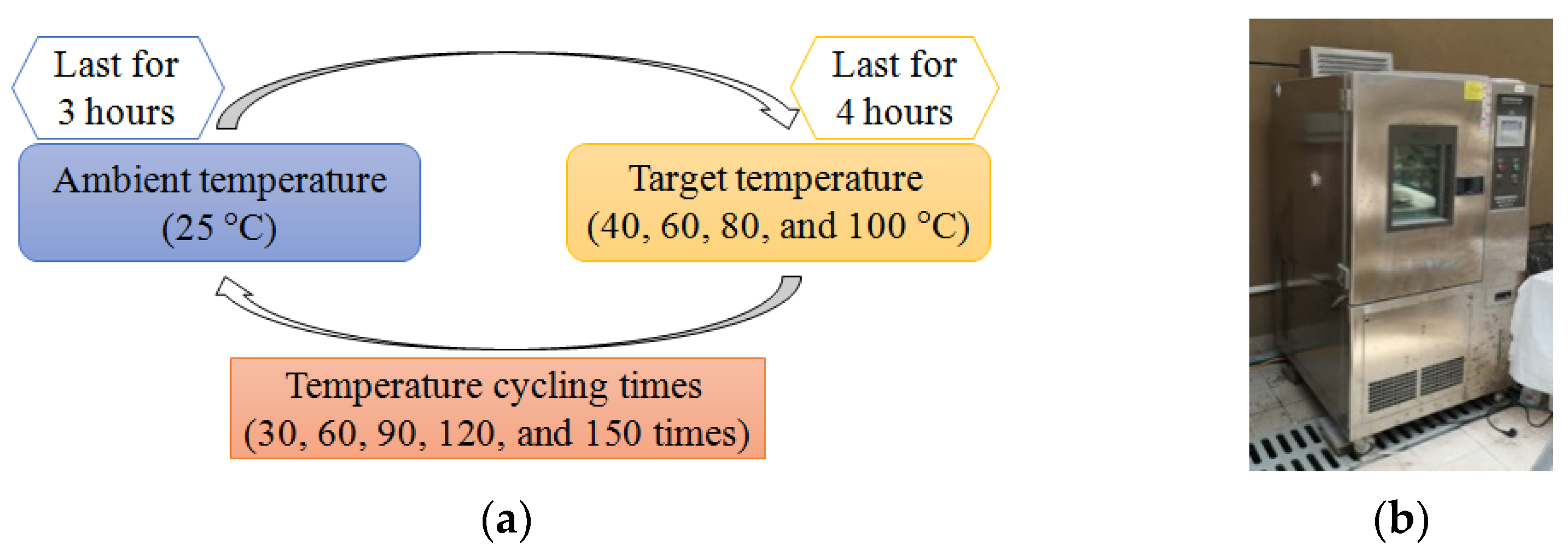
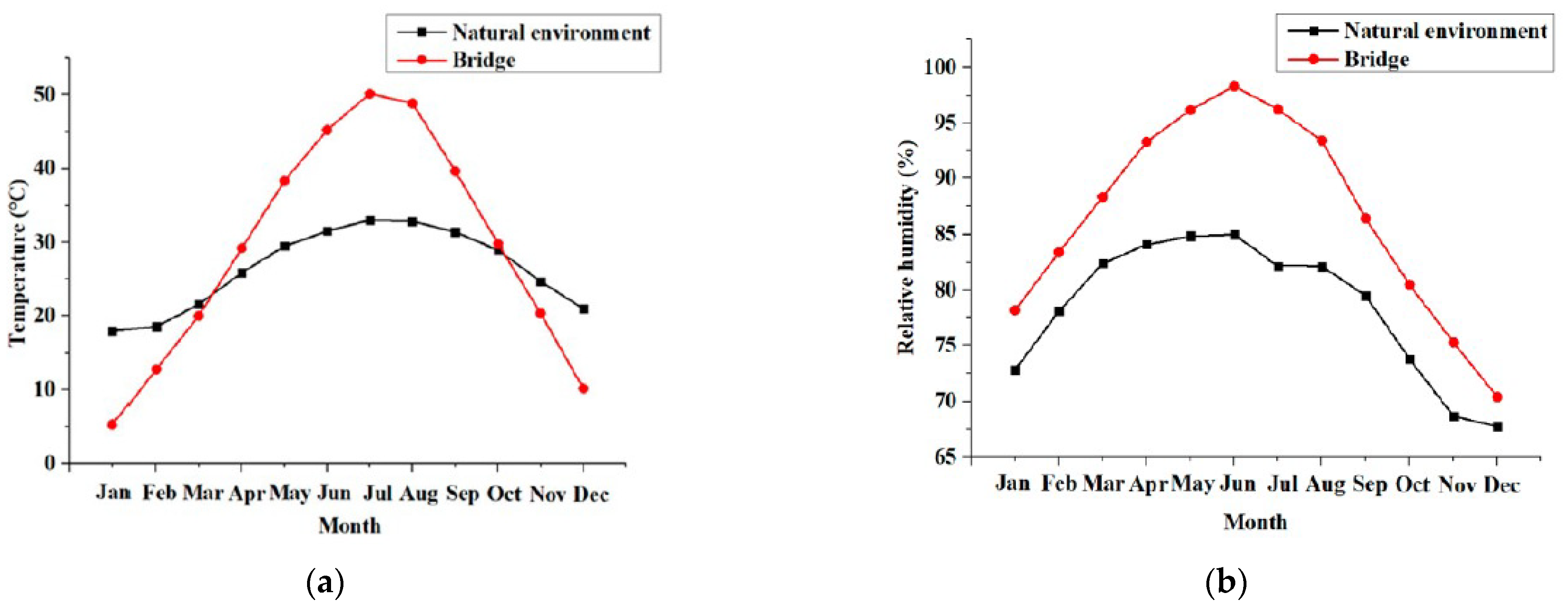
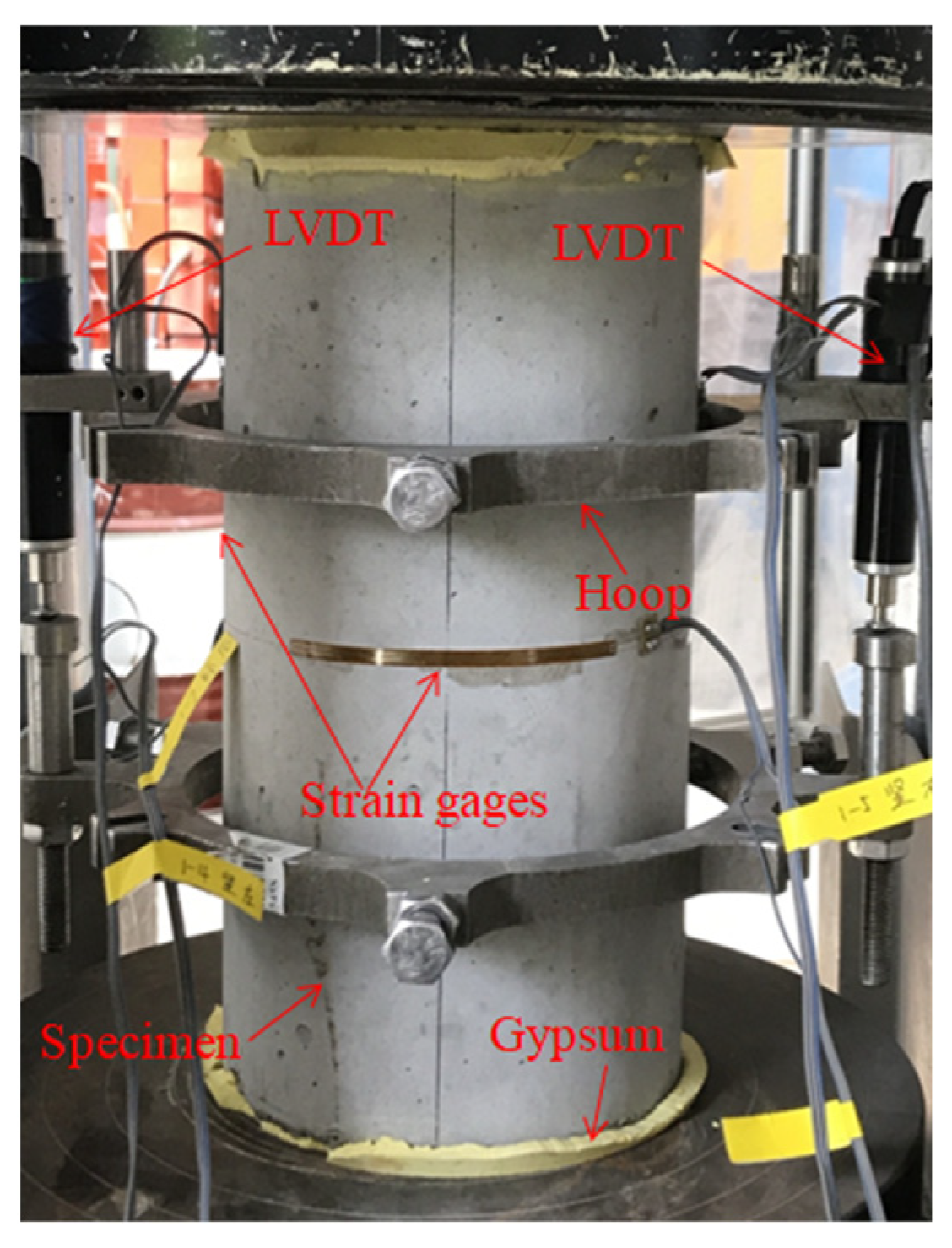

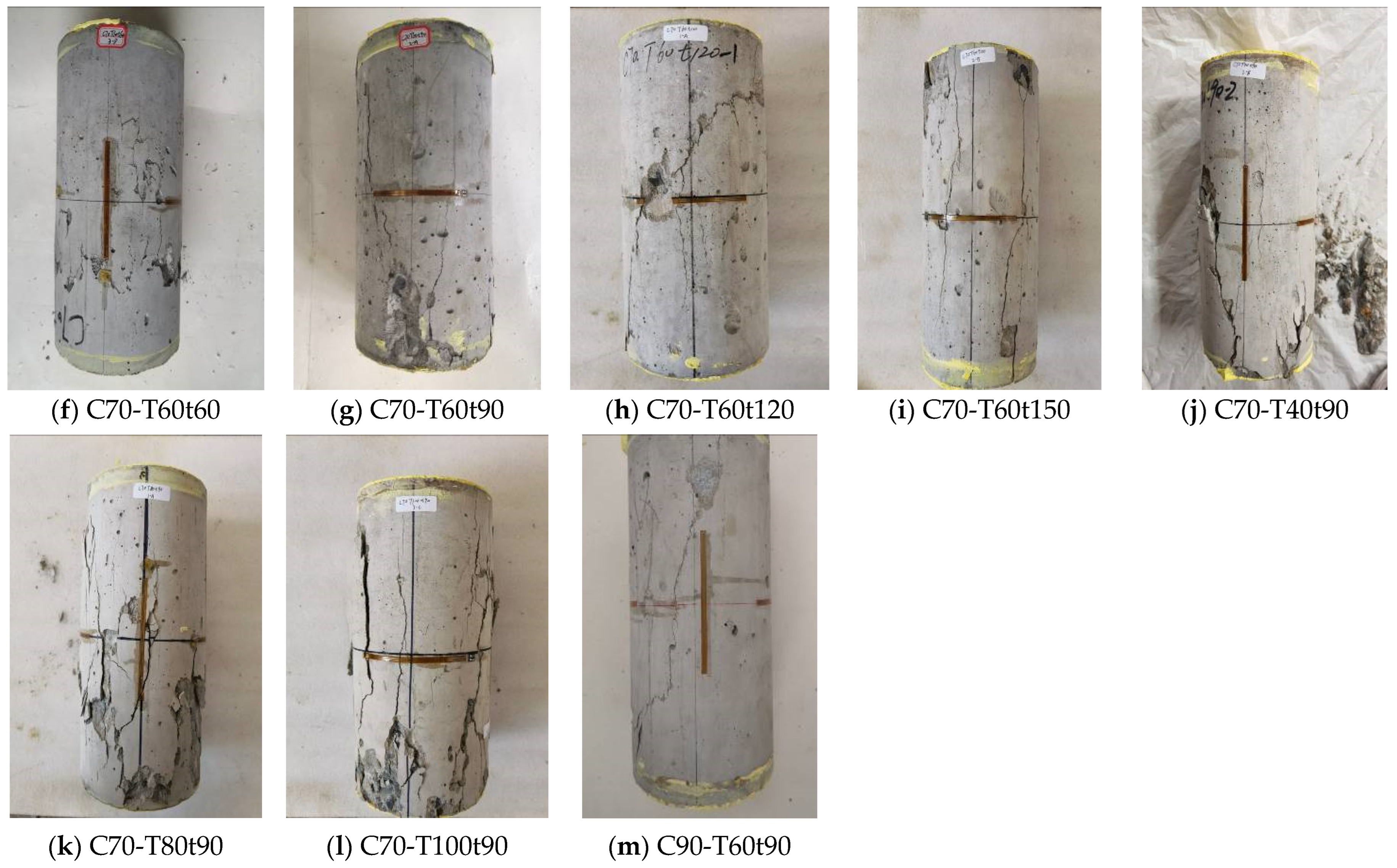
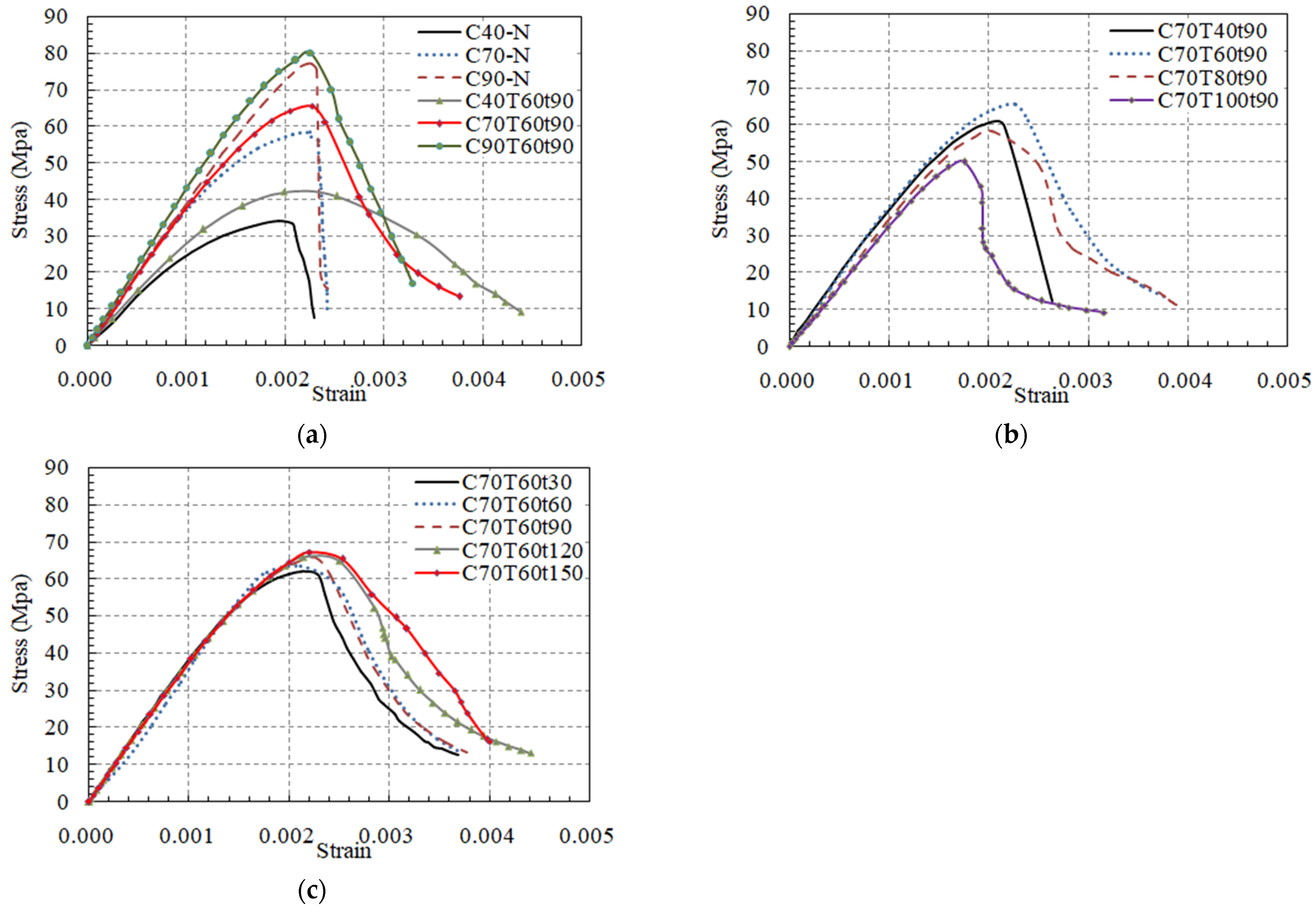


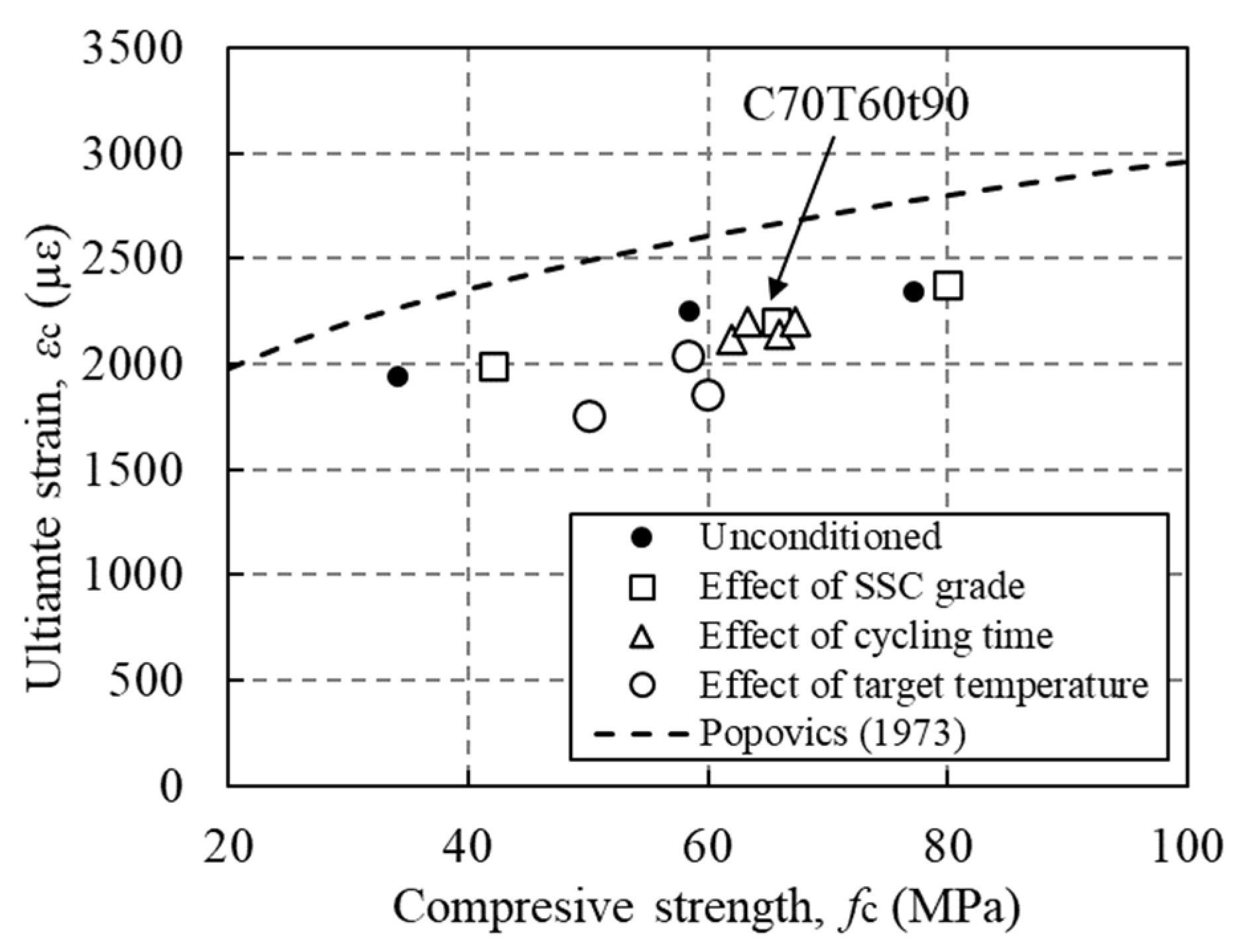
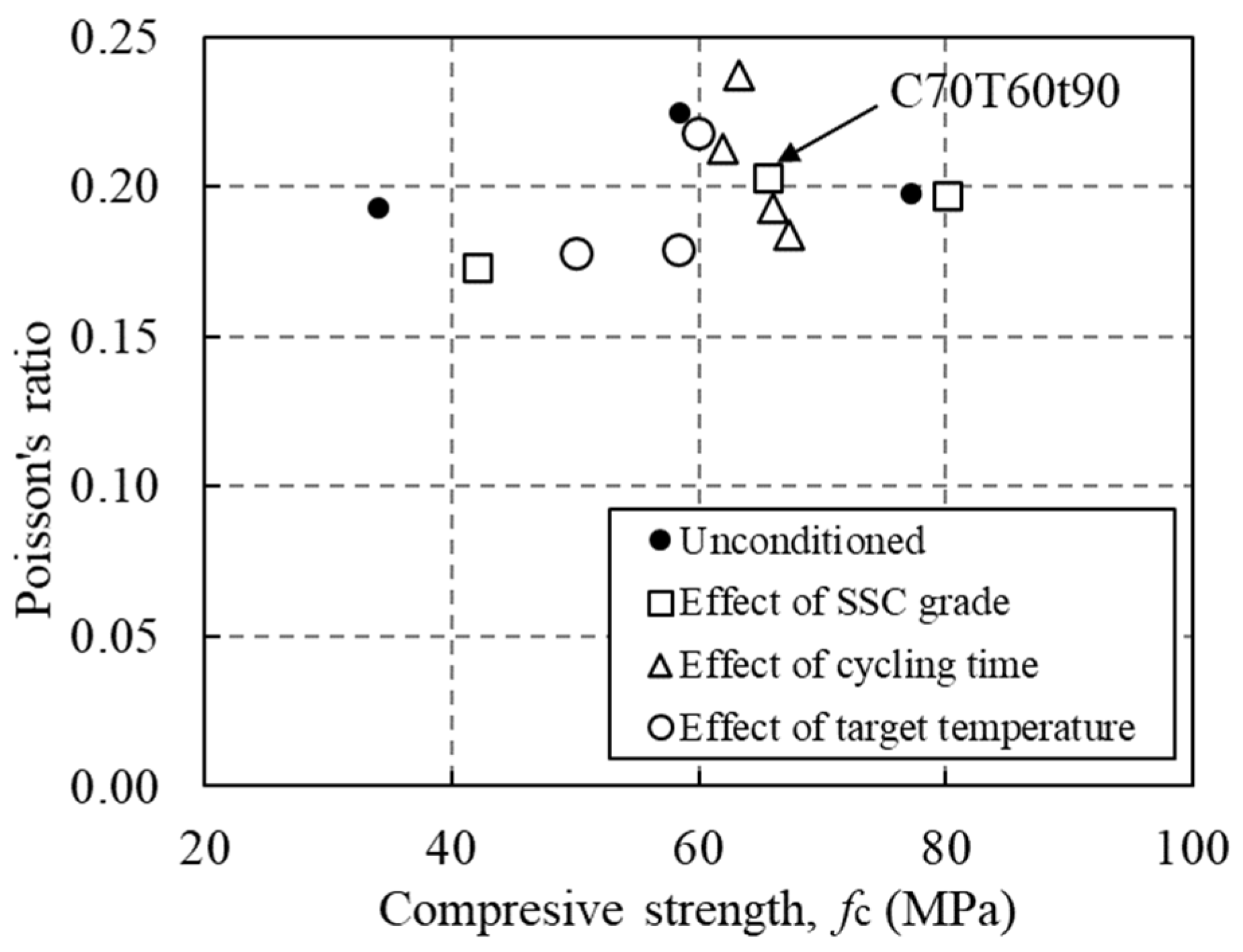

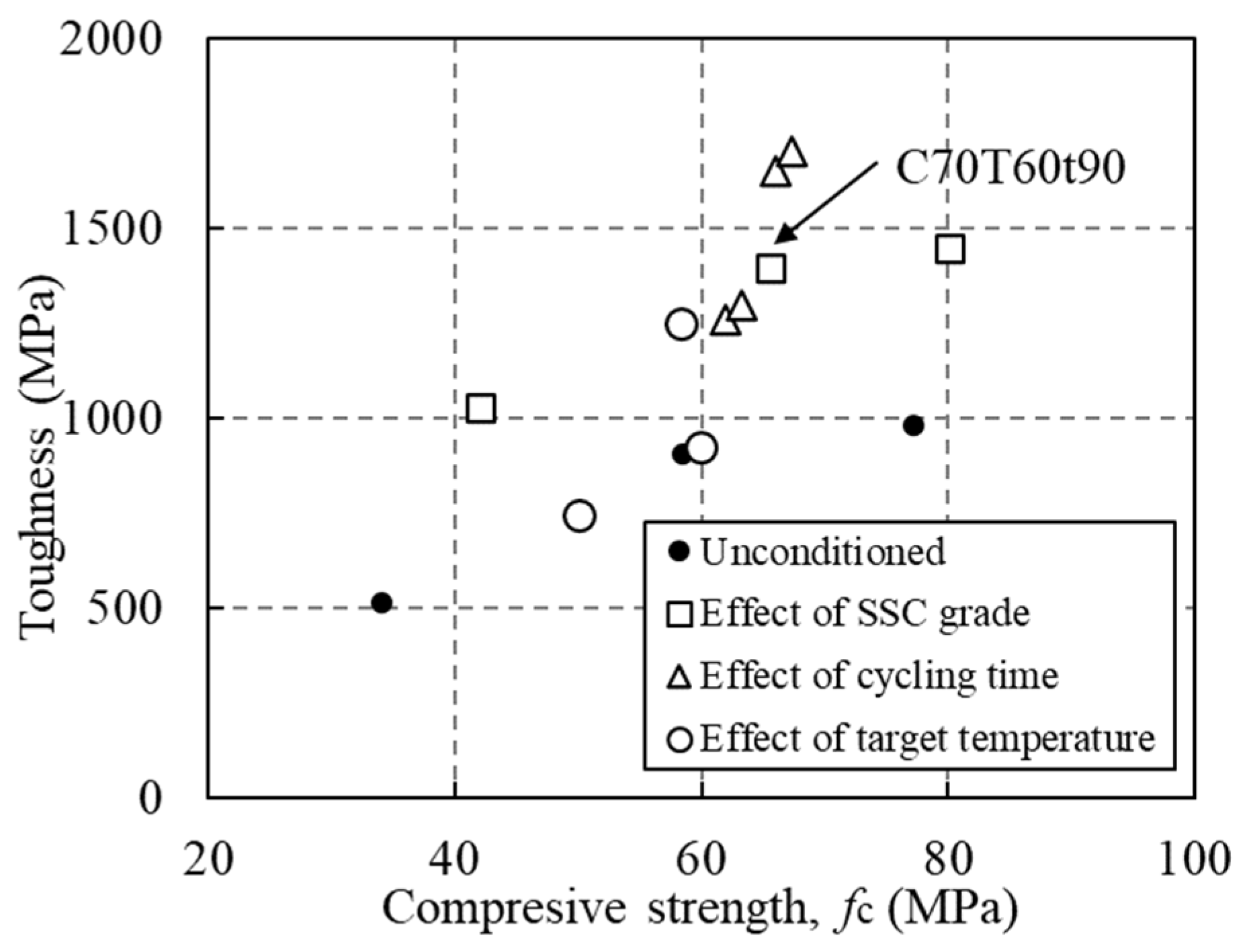


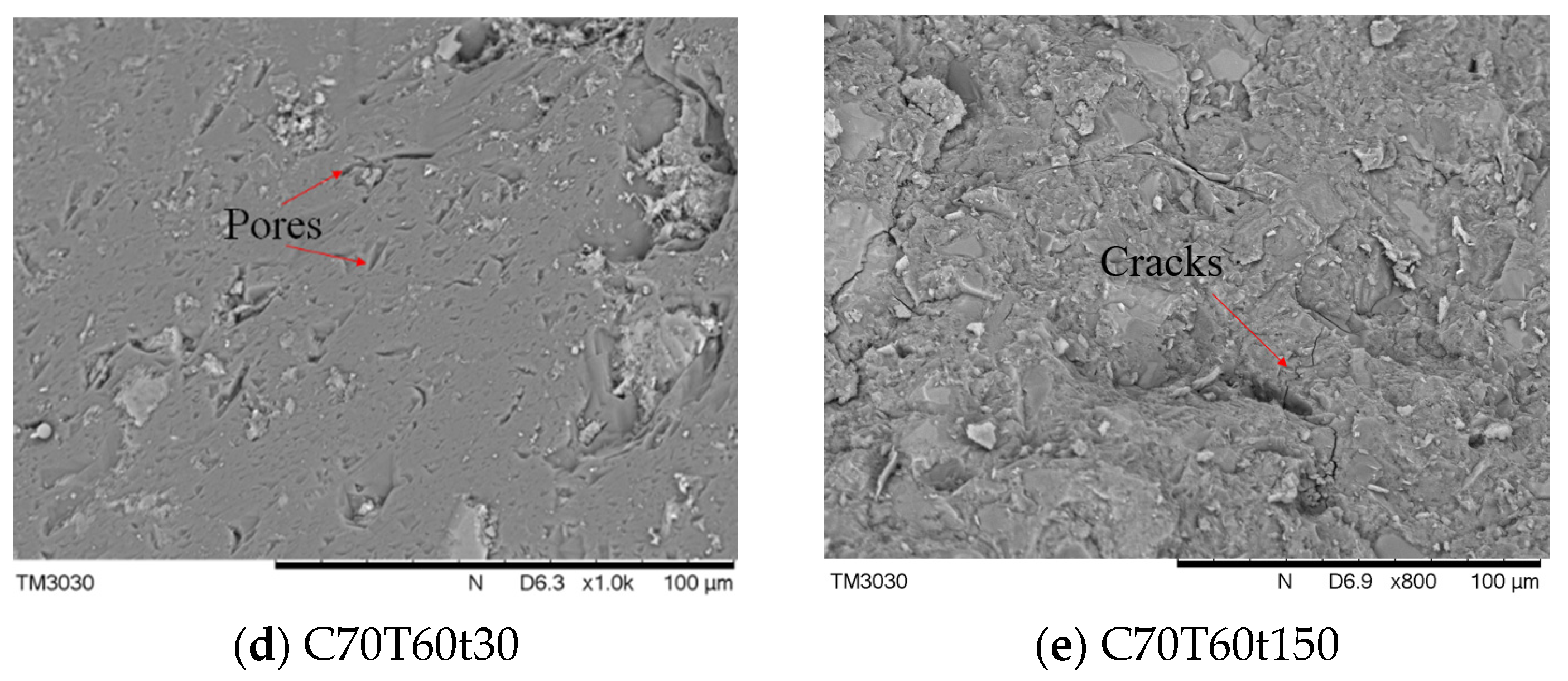
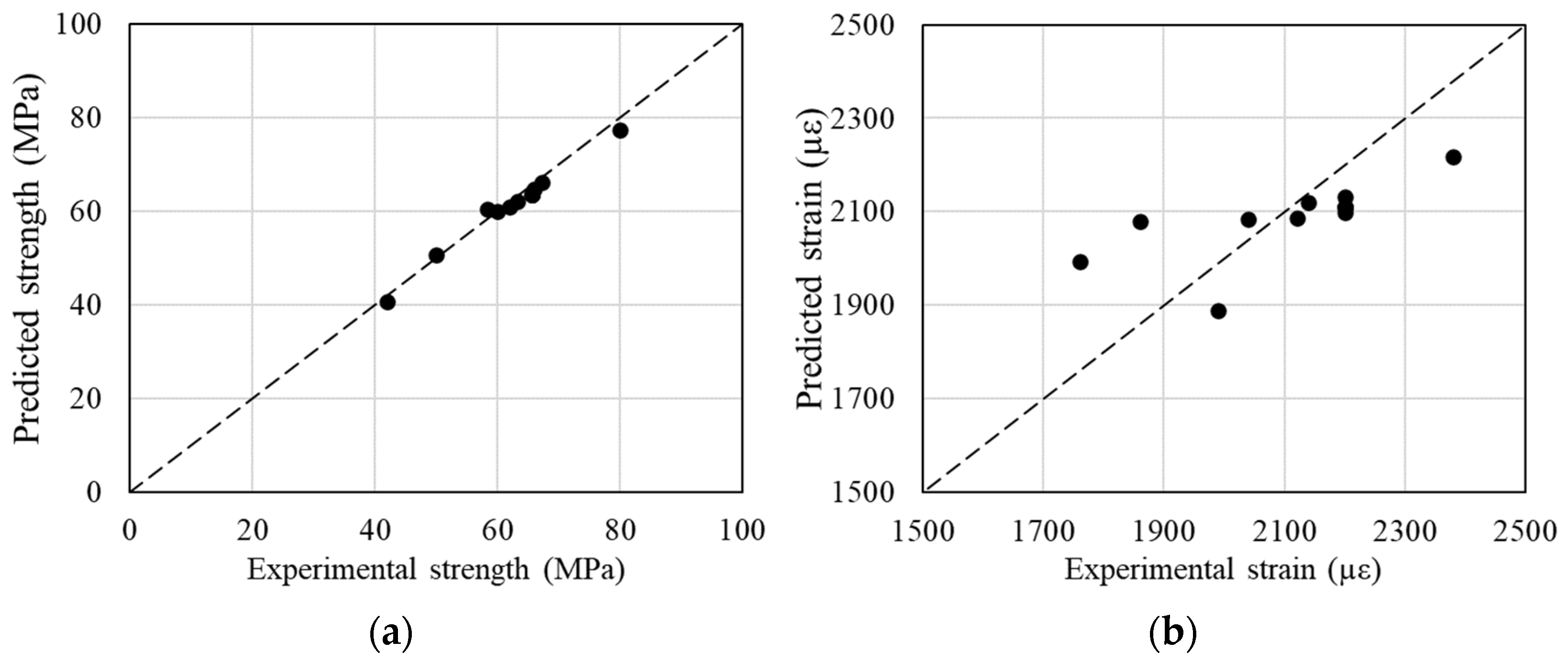
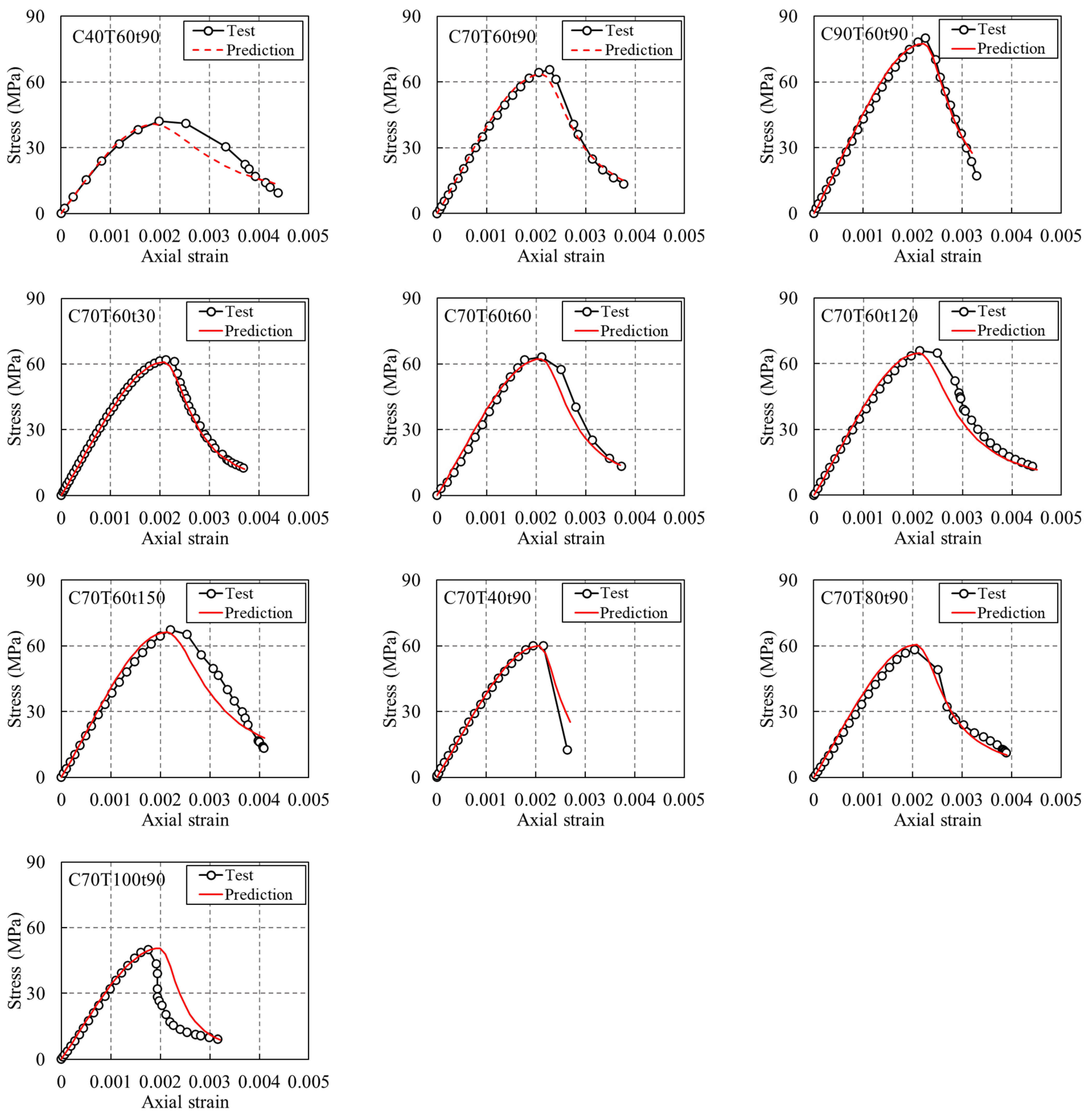
| Concrete | Cement: Seawater: Sea Sand: Gravels: SP (by Weight) |
|---|---|
| C40 | 1:0.55:2.101:3.151:0.008 |
| C70 | 1:0.38:1.613:3.276:0.01 |
| C90 | 1:0.295:1.054:2.24:0.01 |
| Specimen | Ec (GPa) | υ | εc (µε) | Toughness (MPa) | |
|---|---|---|---|---|---|
| C40-N | 34.1 | 26.9 | 0.19 | 1940 | 513 |
| C70-N | 58.4 | 37.0 | 0.23 | 2250 | 905 |
| C90-N | 77.2 | 41.5 | 0.20 | 2340 | 977 |
| C40T60t90 | 42.1 | 29.8 | 0.17 | 1990 | 1025 |
| C70T60t90 | 65.7 | 39.5 | 0.20 | 2200 | 1394 |
| C90T60t90 | 80.1 | 42.4 | 0.20 | 2380 | 1447 |
| C70T60t30 | 61.9 | 39.7 | 0.21 | 2120 | 1256 |
| C70T60t60 | 63.3 | 40.0 | 0.24 | 2200 | 1297 |
| C70T60t120 | 66.0 | 38.4 | 0.19 | 2140 | 1647 |
| C70T60t150 | 67.3 | 37.9 | 0.18 | 2200 | 1700 |
| C70T40t90 | 59.9 | 37.3 | 0.22 | 1860 | 923 |
| C70T80t90 | 58.3 | 34.3 | 0.18 | 2040 | 1248 |
| C70T100t90 | 50.0 | 32.3 | 0.18 | 1760 | 744 |
Publisher’s Note: MDPI stays neutral with regard to jurisdictional claims in published maps and institutional affiliations. |
© 2022 by the authors. Licensee MDPI, Basel, Switzerland. This article is an open access article distributed under the terms and conditions of the Creative Commons Attribution (CC BY) license (https://creativecommons.org/licenses/by/4.0/).
Share and Cite
Qiao, S.; Xiong, Z.; Li, Y.; Ye, Z.; He, S.; Li, L.; Zeng, Y. Mechanical Properties of Seawater Sea-Sand Concrete Exposed to Daily Temperature Variations. Buildings 2022, 12, 517. https://doi.org/10.3390/buildings12050517
Qiao S, Xiong Z, Li Y, Ye Z, He S, Li L, Zeng Y. Mechanical Properties of Seawater Sea-Sand Concrete Exposed to Daily Temperature Variations. Buildings. 2022; 12(5):517. https://doi.org/10.3390/buildings12050517
Chicago/Turabian StyleQiao, Sihua, Zhe Xiong, Yinglei Li, Zhiwei Ye, Shaohua He, Lijuan Li, and Yin Zeng. 2022. "Mechanical Properties of Seawater Sea-Sand Concrete Exposed to Daily Temperature Variations" Buildings 12, no. 5: 517. https://doi.org/10.3390/buildings12050517
APA StyleQiao, S., Xiong, Z., Li, Y., Ye, Z., He, S., Li, L., & Zeng, Y. (2022). Mechanical Properties of Seawater Sea-Sand Concrete Exposed to Daily Temperature Variations. Buildings, 12(5), 517. https://doi.org/10.3390/buildings12050517






